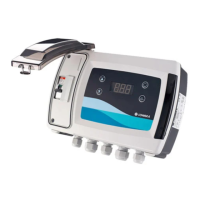en - Original instructions
54
The Auto-test of pump 1 has failed. The test is
stopped due to intervention of the membrane
pressure switch connected to the D IN PROG
(c38=1). The pressure in delivery side achieves
the setting of the pressure switch.
Causes/solutions
• The pump (impeller or diffuser) is damaged.
Contact the technical assistance service.
• The motor pump 1 doesn’t run:
o It is damaged and must be replaced.
Contact the technical assistance service.
o The thermal protector inside the motor
is faulty or broken.
o The capacitor is damaged.
Troubleshooting:
The Auto-test of pump 2 has failed. The test is
stopped due to intervention of the membrane
pressure switch connected to the D IN PROG
(c38=1). The pressure in delivery side achieves
the setting of the pressure switch.
Causes/solutions
• The pump (impeller or diffuser) is damaged.
Contact the technical assistance service.
• The motor doesn’t run:
o It is damaged and must be replaced.
Contact the technical assistance ser-
vice.
o The thermal protector inside the motor
is faulty or broken.
o The capacitor is damaged.
Troubleshooting:
The pressure value has reached the set value of
the high pressure switch P MAX.
All the pumps are stopped.
The alarm is excluded in manual mode.
Causes/solutions
• The pressure has reached the set value of the
high pressure switch P MAX: check the pump
performance curve and the proper set point
(r07) or thresholds of the pumps (r11, r13).
• If the alarm appears but the pressure value
does not reach the value of the pressure
switch P MAX:
o The maximum pressure switch must be
replaced.
o The cable of the pressure switch is
faulty or worn, replace it.
o Check connection of the pressure
switch P MAX to the Q-SMART control
panel terminal (see figures
6, 7 and 9).
o The pressure switch P MAX is dam-
aged, replace it.
Troubleshooting:
The pressure value has reached the set value of
the minimum pressure switch P MIN. LEDs (4), (6)
on.
All the pumps are stopped.
The alarm is excluded in manual mode.
Causes/solutions
• The pressure has reached the set value of the
minimum pressure switch P MIN. Check the
pump performance curve and the proper set
point (r07) or thresholds of the pumps (r10,
r12).
• If the alarm appears but the pressure value
has not reached the set value of the pressure
switch P MIN:
o The pressure switch P MIN is damaged
and must be replaced.
o The cable of the pressure switch is
faulty or worn, replace it.
o Check connection of the pressure switch
P MIN to the Q-SMART control panel
terminal (refer to figures
6, 7 and 9).
• The pump (impeller or diffuser) is damaged.
Contact the technical assistance service.
• The motor doesn’t run:
o It is damaged and must be replaced.
Contact the technical assistance ser-
vice.
o The thermal protector inside the motor
is faulty or broken.
o The capacitor is broken.
Minimum pressure out of op-
eration range.
Troubleshooting:
Tripping of the protection against operation of the
pump below the minimum pressure. The signal
arrives from the minimum pressure switch con-
nected to the digital input D IN PROG (c38=1). If it
appears during normal operation instead of during
the auto-test phase, all the pumps are enabled in
order after the set delay time (t38) to restore the
pressure.
Causes/solutions
• There is an alarm but the pumps are stopped:
o The pressure switch is faulty or its cable
is damaged. Replace the pressure
switch or cable.
o Incorrect setting of the pressure switch,
change it.
• There is an alarm but the pumps are running:
o The pressure switch is faulty or its cable
is damaged. Replace the pressure
switch or cable.

